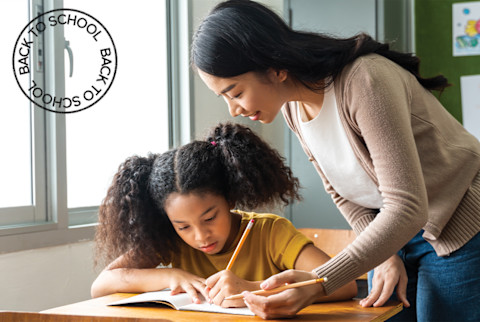Back-To-School Anxiety? Four Essential Mindfulness-Based Practices For Educators

Whether it felt like your hair was constantly on fire or you loved the challenge of new teaching methods, the 2020–2021 school year left most educators feeling some level of burnout, depleted, and desperately needing time to recharge. More than once, last year, I was reduced to a nonverbal puddle melting into the couch, wondering how I was going to get back up and do it again the next day. So, it's no wonder that as many educators are back in the classroom for this new school year, we're doing so peeking out from behind our fingers and wondering what exactly this new year will bring.
Teachers are multitaskers, go-getters, and low-key superheroes. It tracks that we begin the year with all the good intentions to meal prep, lay out our clothes the night before, and finally get that morning routine going.
Sometimes, however, these well-meaning practices can feel like one more task on the to-do list. By incorporating mindfulness practices into our daily routines, as they are already, we create strength, cultivate adaptability, and develop a more positive mindset:
Identify stressors.
Chances are, this upcoming school year is going to be another wild ride. Having that "But I don't wanna" feeling when we think about returning makes complete sense. So, rather than ignore these feelings or shame ourselves, we need to name potential concerns and anxieties.
Have a difficult conversation with your stress: Journal your anxiety. Get in the car, blast some music, and yell about what's bugging you. In order to process, we need to look our stressors in the eye and say, "OK. I see you. I acknowledge you. And now I'm moving on." By looking under the bed, we begin to dismantle the scary, disconnect from the emotion, thereby allowing ourselves to respond rather than react.
Divide and conquer.
After identifying the stressors, we determine what we can control (a killer first-day-of-school outfit) and what we cannot (the school's back-to-school still-in-a-pandemic who-knows-what's-happening "plan"). Make a list of each, acknowledging what you can't control but also crossing it off your list of things to worry about. Give your attention to what you can control and create a plan, determine actionable steps, and be honest about what's doable.
Often when we're overwhelmed, we forget the resources we do have access to. Whether it's with prepping dinner or asking a colleague to watch your class for five minutes so you can take deep breaths in the restroom—pause to determine where you can ask for help.
Set boundaries.
Protect your time and your energy. As people whose inherent inclination is toward helping, it's very easy for teachers to keep saying yes and to make it easier for others—often at their own expense. If happy hour has a tendency to become a draining loop of venting and rehashing, politely decline. If the teachers' lounge is a toxic space of complaining, get some fresh air and take a quick walk. If your students need to wait just one extra day to get their papers back because you need to get sweaty and throw some weights around after work, they'll be OK. I promise. Boundaries create space for you to be more present. When you're more present, you thrive inside and outside of the classroom.
Acknowledge the good.
When you're up to your eyeballs in Jane Eyre essays to grade, it can be difficult to feel positive, let alone grateful. However, practicing small moments of gratitude among the chaos is a game-changer. Because of our brain's neuroplasticity, purposely guiding our attention toward the beneficial or pleasurable can create new neural connections and actually rewire our brain to be more positive. This doesn't require being overly optimistic all the time. We are only human, after all.
Rather, it means taking 10 seconds to intentionally acknowledge how magical that first sip of coffee tastes. Or silently celebrating the accomplishment of gaining another human's trust when a student comes to you for help. A consistent practice of taking in the good cultivates more resilience and feelings of contentment.
The takeaway.
We can't predict what the future holds, but we can take some steps to ensure we approach the year from a place of strength, calm, and empowerment. One thing at a time, one deep breath at a time—you got this.
